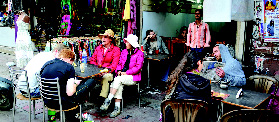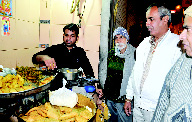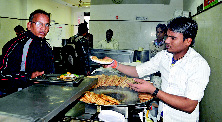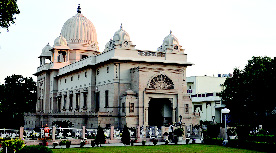
Not many will know that Paharganj, which is a thriving tourist place in the heart of Delhi today, was witness to the bloodiest of Hindu-Muslim riots, which changed the character of this place forever. A Muslim-dominated area since the Mughal period, Paharganj witnessed a massive influx of Hindus from across the border in 1947. They were given shops, houses and space to make a fresh start in life. The hard work and dedication of this community, coupled with the astute business sense of the local banias, has helped Paharganj’s transformation into an export hub, and a backpackers’ paradise. The ‘hippie’ movement in the seventies also greatly helped in this transition, say old timers.
Sardar Dharm Singh, whose father migrated to Paharganj from United Punjab, says that though this area has been transformed and changed physically, the spirit of togetherness still stays. The markets may have transformed, but the customs, traditions and big-heartedness can still be seen on the streets and bazars. It is interesting that every major event in the National Capital, whether related to sports or trade, has affected the fortunes of this area.
The advent of the hotel industry in Paharganj started with the opening of the New Delhi Railway Station—between Paharganj and Ajmeri Gate—but got a major fillip by the India International Trade Fair held in 1972, the Asiad in 1982, and the recently held Commonwealth Games. “It was during the ‘hippie’ period that this area acquired a notorious reputation of drugs, sex and crime – which, though slowly fading away, still sticks,” says Jagjit Chhabra, who has a real estate and exports business in the famous Main Bazar.
Paharganj of today is home to numerous hotels, restaurants and handicraft shops, that cater to the foreigners as well as domestic tourists and businessmen. A room can be had for anywhere between Rs. 500 to 2,000, and the options are varied. All kinds of food and liquor are available, including foreign cuisines.
For a visitor from Gurgaon, visiting Paharganj would be easier if you take the Metro, and get off at the Ramakrishna Mission Ashram Station on the Dwarka line. Just outside the Station, to the right, the Ashram attracts both the religious and the curious – with a beautiful gate, through which the inner temple can be seen. Swami Shantatmanand Ji, Secretary of the Delhi Chapter, says that their basic philosophy is to work towards the emergence of a civilisation based on harmony, goodwill, peace and service. “The Ashram has been here for more than 80 years. In the fifties Swami Ranganatha Nand ji headed this place, and every Sunday more than a thousand people used to come to hear his sermons. Even the late PM Jawahar Lal Nehru, his daughter Indira, and PM Lal Bahadur Shastri used to come here,” informs Swamiji. Presently the Ashram is running a well-stocked library, a clinic, and 60 centres in and around Delhi, which are imparting spiritual education and values to the followers, as well as the general public. The Ashram also carries out a lot of work to help the needy, following the dictum of ‘Shiv Gyan se Jeev Seva’.


Just a hundred metres to the left of the Ashram is the historic Chitragupta Mandir, which stands as a monument to the time when the Yamuna flowed close to Paharganj, and people would sit under the trees and enjoy the tides. It is under one such tree that the late Nand Lal Sharma set up an eatery around 80 years back, which his family has turned into a famed hotel and restaurant called the Metropolis. This hotel has become a legend for its food, particularly the Russian offerings such as Chicken a la kiev. A visitor at the Hotel says that the quality of the food, the presence of a number of fellow foreigners, and personalised service has turned him into a loyal patron. Walk a few metres to the left of the Hotel, and you will find the famous Lassiwalas, on the road that goes to Chuna Mandi. You will find foreigners enjoying the butter milk, even as they haggle to get rid of the touts – who no doubt are a menace on the streets. Just opposite the lassi stalls you will find My Bar, a famous place for reasonably priced food and liquor. A number of foreigners, including Poles, Russians, and some from the African countries, are busy talking, as they enjoy the spirits in the warmth of this Bar.
From the Lassiwalas we move to Chuna Mandi, which houses the famous Imperial Talkies, which was once a favourite entertainment haunt. Sitaram Dewan Chand Bhaturewala, and the Malhotra restaurant, are also located here – as is Khanna Talkies. The arrival of Shiela Cinema, nearby, with the first 70 mm screen in Delhi, led to the decline of these two talkies.
Rajesh Gupta says, “After watching the films we used to go to the famous Sitaram Dewan Chand Bhaturewala. It used to be a regular affair,” he says with a smile.
Vineet Kohli, who is the grandson of Sita Ram, says that the USP of their Chhole Bhature is that these are fried in little oil, and the best raw material goes into them. “We have tried to maintain the taste and quality that was perfected by our grandfather,” says Kohli. Vishal Aggarwal, who has been visiting the shop since the last 20 years, and lives nearby, says that apart from the rate, the taste, ambience and service in this shop has not changed much.
The Malhotra restaurant serves Indian and Continental food in style; owner Harish Kapoor says that their core competency is fresh food, made to order and customised in a kitchen upstairs. “We are almost a sixty year old establishment, and have changed with the times. The business overall has been good, as this place has assumed the character of an international tourist centre. The arrival of the Metro has helped this area a lot, and now people from other parts of Delhi also come to explore it,” says Kapoor, who is however unhappy with how successive governments have failed to help this area.
Sandeep Bhasin, who has been doing business in the area for a long time, opines that infrastructure is not in proper shape, the roads are not well maintained, and the sanitation and sewage conditions need much improvement. “We need the government to intervene and improve the face of Paharganj,” says Bhasin. Gupta further says that building bylaws in the area need to be defined, as the MCD has declared this to be a special area. “This has made life difficult for residents as well as businessmen, as no one knows what one can do and what one can’t,” he says.

Sitting at a corner table in the Malthotra restaurant is Elinor Ben Or from Israel who has been living in this area for a year now, and is a student of jewellery designing in a school nearby. “I have been living with loads of patience, as the civic facilities are a bit on the downside. However, there are a lot of foreigners in the area, good food is available, and it is centrally located,” says Elinor. She however dislikes the dingy streets, the exessive crowds, and lack of respect for women – which she says is visible in how men look at them. She also says that the general perception that Paharganj is a seedy place is wrong, and other people from Delhi should also come here to see the world in a microcosm. Her primary grouse with the government is the poor conditions of the street children, who she says have lost their future because no one takes care of them. “If I was the Prime Minister I would ensure that they get a home to stay, are educated, and well-fed,” she asserts.
From Chuna Mandi we move back to the Main Bazar in Paharganj, where a fine handicraft shop beckons. It has all kinds of leather goods, hand made paper goods, diaries, clothes, and stuff that we use to decorate our homes. Nand Lal Gupta says that most of the visitors are from Poland these days; during January the Koreans come, while Israelis are regular.
Just a few metres from this shop is the famous Jackson Book Stall, that claims to have books in 32 languages. Deepak Dialani, owner, says that visitors from across the world come to buy books from his shop – and the most popular ones are in English and French. “The foreigners love to read books. ‘Shantaram’ has been the most popular book in the last one or two years,” he says From books, to food which a Gurgaonite will love – the Gem Bar and Restaurant, Diamond Café (opposite Vivek Hotel), Sam’s Café, Madan Café, German Bakery, Khosla Café and Pehalwan Da Dhaba.
To top it all is Pandit Pakore Wale, where the third generation is running the shop in the famous Chhey Tuti Chowk, which is also the heart of this area. Amit Bhardwaj, owner of the shop, says that he has sold pakoras to people from almost all nationalities. “We are happy to work and live here. Our Kachoris, served with alu sabzi in the morning, is a dish to be relished – and not to be described in words,” he asserts. As we reach the other end of the Main Bazar, just opposite the New Delhi Railway Station, the whiff of desi ghee coming from the shop of Ram Prasad Durga Prasad is overwhelming. This shop is famous for the seasonal Dal Halwa, Suji Halwa, and Karachi Halwa, along with other sweets. “We make sweets in the traditional way, using the purest ghee and other raw materials. It is our endeavour to sell the best to our customers, as we have a legacy to maintain,” says Prasad.
The New Delhi Railway Station handles over 300 trains daily, serving almost 3,60,000 passengers on an average day. An official says that this Station has the largest route-interlocking system in the world. It was in 1926 that a building came up along this line, to give it the name of a proper station. Interestingly, the railway station was planned to be set up in the Central Park of Connaught Place, but the idea was rejected as it was found to be impractical. Prior to that the Agra-Delhi line used to cut through Lutyens Delhi, and it was shifted along the Yamuna river, to make way for the New Capital.
Paharganj was one of the five main markets of Delhi, and the only one outside the walls. It was a grain trading centre, and an important hub for tax collection. It derives its name from the nearby Raisina Hills (Pahar).
Close to Paharganj, in Nabi Karim, one can also find the Dargah Qada Sharif, which was built by Emperor Firoz Shah Tuglaq, in memory of his son Fateh Khan. It comprises of a large square tomb, which he had built for his own use, but later his son’s remains were interred here. In Chuna Mandi one comes across the Hari Masjid, which has a madrasa attached to it.
A number of such historic monuments, including buildings built in the British and Mughal style, can still be seen in between the mushrooming new constructions. A visit to the lanes and by lanes of Paharganj will definitely give a visitor a glimpse of the real India— that has imbibed varied influences, and yet retained its unique flavour.
Read More...